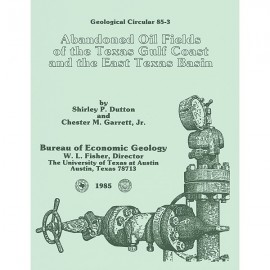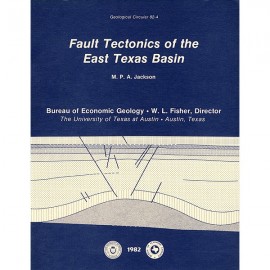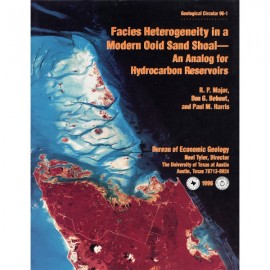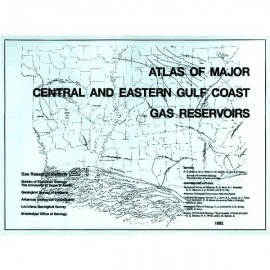Geological Circulars
-
Books & Reports
- Reports of Investigations
- Guidebooks
- Udden Series
- Geological Circulars
- Down To Earth
- Atlases of Major Oil and Gas Reservoirs
- Texas Memorial Museum Publications
- Environmental Geologic Atlas of the Texas Coastal Zone
- Mineral Resource Circulars
- Other Reports
- Seminars and Workshops
- Handbooks
- Submerged Lands of Texas
- Symposia
- Annual Reports
- Open File Reports
-
Maps & Cross Sections
- Thematic Maps
- Miscellaneous Maps, Charts & Sections
- Geologic Atlas of Texas
- STATEMAP Project Maps
- Geologic Quadrangle Maps
- Cross Sections
- Highway Geology Map
- Energy and Mineral Resource Maps
- Shoreline Change and Other Posters
- Wilcox Group, East Texas, Geological / Hydrological Folios
- Bouguer Gravity Atlas of Texas
- River Basin Regional Studies
- Featured Maps
- Posters
- Teachers & the Public
-
Geological Society Publications
- Gulf Coast Association of Geological Societies
- Alabama Geological Society
- Austin Geological Society
- Corpus Christi Geological Society
- Houston Geological Society
- Lafayette Geological Society
- Mississippi Geological Society
- New Orleans Geological Society
- South Texas Geological Society
- GCS SEPM Publications
- Historic BEG & UT Series
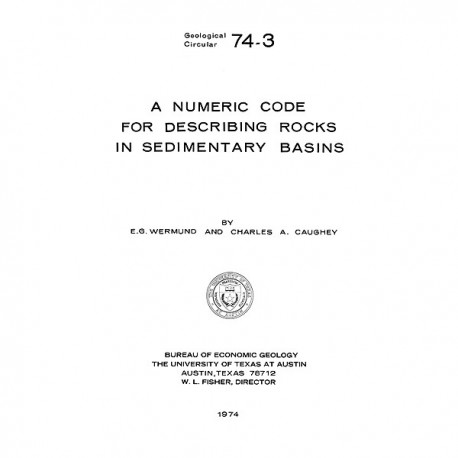
A Numeric Code for Describing Rocks in Sedimentary Basins
GC7403
A free, digital version of this publication can be found on: Texas ScholarWorks
GC7403. A Numeric Code for Describing Rocks in Sedimentary Basins, by E. G. Wermund and C. A. Caughey. 28 p., 4 figs., 3 tables, 2 appendices, 1974. ISSN: 0082-3309. Print.
To purchase this publication as a PDF download, please order GC7403D.
ABSTRACT
The purpose of this paper is to present a system of encoding rock data for multiple uses that include (1) mapping subsurface stratigraphy for economic exploration, (2) cataloging borings used in subsurface waste disposal, and (3) building a library of natural resource information. Regional surface and subsurface stratigraphic studies for exploration in sedimentary basins commonly require the handling of numerous columnar sections that display rock descriptions collected from both outcrop and borings. Data of the borings are core descriptions, logs of cuttings or ditch samples, and mechanical logs of physical properties such as self potential, resistivity, gamma, gamma-neutron, and others. It is not unusual in a regional problem for a geologist to use columnar data from 2,500 or more localities (Wermund and Jenkins, 1970; Galloway and Brown, 1972). One way of handling large stratigraphic data files is to describe the rocks in a computer-compatible format. Whenever lithofacies mapping or statistical analyses become a required means toward solving regional stratigraphic problems, a numerical encoding system to describe the rocks becomes valuable. Although there is a large literature on solving regional problems including various numerical (or lithofacies) mapping techniques, little has been written about methods for encoding rock data. At least, the writers are unaware of many published systems for encoding lithologic descriptions. There is considerable evidence (Galley, 1968) that the problem of disposing of man's wastes will increase in size and complexity and that waste disposal into deep wells will become more common than now. This will be especially true regarding disposal of radioactive wastes (Kubo and Rose, 1973). A catalog of possible deep disposal sites for which the lithologic sequence is encoded will be a valuable adjunct to decision making. Even for shallow pits at the surface which are more in demand the encoding of lithology will be useful. Related to the above needs, increased interest in the construction of environmental and natural resource inventories gives further impetus toward encoding rocks. This interest concerns ongoing active legislation to formulate land use policy and law. Government agencies at all levels, foreseeing their responsibilities in land management, actively discuss many kinds of classification and information systems, one of which is always a natural resources information system. Examples are land use classification (Anderson, Hardy, and Roach, 1972), the proposed nationwide RALI information system formulated by the U.S. Geological Survey (Clarke, 1973), and a Texas natural resources information system (Interagency Council on Natural Resources and Environment, 1973). Part of any natural resources information system requires the description of typical sections of rock in representative or critical geographic regions. If these natural resources systems are to be computer-compatible, then a lithologic encoding system will be an essential element.
Keywords: rock classification, basins, waste disposal, sedimentary rocks
Citation
Wermund, E. G., and Caughey, C. A., 1974, A Numeric Code for Describing Rocks in Sedimentary Basins: The University of Texas at Austin, Bureau of Economic Geology, Geological Circular 74-3, 28 p.

